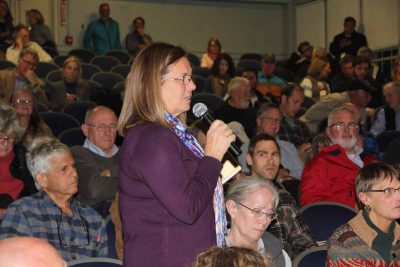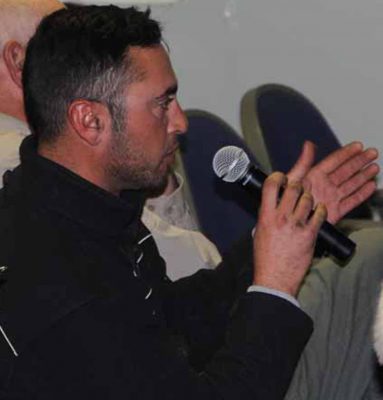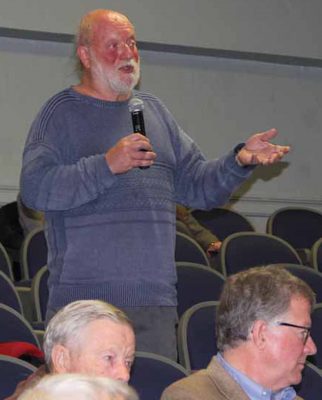
Story and photos by Judy Benson
There are eelgrass beds and forested wetlands, tidal marshes and sandy-bottomed coves, bedrock shorelines and places where rare and endangered animals including Atlantic sturgeon, New England cottontail rabbits and piping plovers can be
found.
This wide diversity of habitats is a key feature of the area of the southeastern Connecticut shoreline designated to be part of what could become Connecticut’s only National Estuarine Research Reserve, project leader Kevin O’Brien told more than 100 people at a public meeting on Nov. 13. If successful, the Connecticut site would join a
network of 29 other NERR sites across the country.
“We had to make sure we brought something unique to the system,” O’Brien, environmental analyst in the Land and Water Resources Division of the state Department of Energy and Environmental Protection said to the roomful of environmental advocates, shellfish farmers, marine scientists and others gathered at UConn’s Avery Point campus in Groton. The meeting was the culmination of a two-year effort by a team from DEEP, the University of Connecticut and Connecticut Sea Grant to evaluate

potential sites and select one for nomination.
Input from the meeting and written public comments would contribute to the application planned for submission in December to the National Oceanic and Atmospheric Administration. NOAA oversees the NERR network, which extends from coastal to Great Lakes states. Each site operates as a federal-state partnership, and local environmental and educational organizations often partner with NERR sites on projects and public outreach programs.
“Almost every coastal state has one, and they range in size from big to small,” said Randall Schneider, Mid-Atlantic region lead in NOAA’s Office of Coastal Management. “They serve as platforms to increase research, education and resource stewardship at sites that are locally relevant and nationally significant.” Federal funding of $25 million annually supports 70 percent of the budgets of the NERR sites, supplemented by a 30 percent match from the states.
The Connecticut site would extend from Old Lyme to Mystic – from the lower Connecticut River including Lord Cove and Great Island wildlife management areas and submerged areas at the mouth of the river, to the submerged areas of the Thames and Mystic rivers, to Bluff Point and Haley Farm state parks in Groton.
During the public comment portion of the meeting, several speakers voiced support for the nomination, including Old Lyme First Selectwoman Bonnie Reemsnyder and Claudia Weicker, chairwoman of the Connecticut Audubon Society’s Roger Tory Peterson Estuary Center in Old Lyme. Statewide leaders of Connecticut Audubon and Audubon Connecticut also spoke in favor, along with UConn Marine Sciences Prof. James O’Donnell.
“It’s about time a program like this gets established in Connecticut,” he said. “It will facilitate more estuarine research, and provide enhanced opportunities for public access, and give these areas a higher profile.”
Some audience members sought assurances that the NERR designation would not impose any new restrictions on activities in the area.
“Will this lead to increasing regulations on shellfishing in the area?” asked Marc Harrell, who is developing a commercial oyster farm in the Mystic River.
Another speaker representing the Essex Harbor Management Commission asked whether dredging to maintain navigation channels would face new hurdles.

O’Brien said aquaculture, commercial and recreational fishing, boating, dredging and other permitted projects would be allowed in the NERR, with no new regulatory requirements.
“It would not change anything. It works on the existing regulatory framework,” he said. “If you’re working on this area now, you will still be able to work in that area.”
Chris Bowser, education coordinator of the Hudson River NERR, said shellfishermen partner on projects at that site.
Another shellfish farmer, Jim Markow of the Noank Aquaculture Cooperative, said he supports the application, but also urged the NERR team to recognize the existence of active commercial beds in the designated area.
“This area encompasses part of our grounds. We’ve put a significant investment there,” he said. “We’re willing to help, because a good environment is good for oysters.”
J.P. Vellotti, who farms kelp at a site off Bluff Point within the NERR area, made a similar point.
“We’re out here on the water every day,” he said. “We’re not against this, but you need to reach out to the working watermen.”
Other speakers advocated for greater emphasis on how the NERR designation could protect and enhance water quality in rivers and Long Island Sound.
O’Brien asked that letters of support and comment be submitted to him by Nov. 20 so they could be included in the application. After the submission, the NERR team will begin working on a management plan for the site and an Environmental Impact Statement, a federally required analysis of how the NERR designation would affect natural and cultural resources. Public comment will be sought during that process. A final decision on whether the site will become a NERR site is expected in 1½ to two years.
 Loading...
Loading...
Comments can be sent to: kevin.obrien@ct.gov.
For more information, visit: www.ct.gov/deep/NERR
Judy Benson is the communications coordinator of Connecticut Sea Grant.